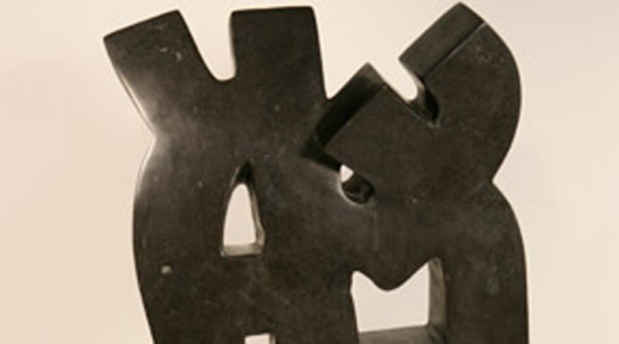"The Solid and The Sublime" Exhibition
Crossing Art

This event has ended.
The exhibition brings together the work of four Asian Contemporary artists using solid materials that inform interpretations of the sublime.
Liu Yonggong carves black Chinese granite into three-dimensional calligraphy sculptures creating his own renditions of traditional Chinese ‘characters’. In Chinese art history, the great calligraphers were ones that had a unique, creative style of ‘writing’ the characters that made up their compositions. Yonggong’s ‘characters’ or ‘words’, transformed into a signature style of stone sculptures, are meant to allude to the Chinese written language but are in fact fictitious. Not only does he reinterpret the tradition of the writing signature style in three-dimensional form but he also pays homage to the origin of the Chinese characters, coming from drawn pictures of what the ‘words’ are meant to represent. His ‘words’ invoke moments; with works like Untitled (The Kiss) and Untitled (The Dance), that resemble sensations associated with the sublime.
The five bronze sculptures on view by Takeshi Hamanaka reveal physical manifestations of sentiments. Hamanaka has reduced the bronze into forms with supple round contours and smooth surfaces. The soft abstract forms mirror that of the sublime but ultimately the material the work is made of is a durable solid forcing the viewer to adjust how they physically relate to the works. The titles, such as Joy, Survival, and Mask of the Wind, coerce us even closer to identifying the awe-inspiring content within the works.
The way in which Zhao Yi incorporates ‘fibers’; wires, silk, foil and rice paper, in her mixed media wall pieces call to mind spirituality, the heavenly or otherworldly. Her ‘fibers’ seem to float or hover on top of the canvas, captured inside glass cases. Yi’s work is influenced by the ideas and principles of Daoism. In the Supreme Realm series, on display in this exhibition, she encapsulates the yin and yang of Dao and searches for the harmony between heaven and nature by literally “unraveling” the fabric that seems to hold it all together.
Lin Shih Pao’s Heavenly timing, Earthly Advantage, Human Harmony series reflects the most profound concepts of Asian philosophy, namely a deep sympathy for human beings and an appreciation of the value of the union of humans and nature. The circle with the square hole in the center, repeated throughout Shih Pao’s work, is a symbol that reflects the ancient principle that ‘heaven is round and earth square’. It is also an icon used in outdated Chinese currency, produced specifically as a bronze coin. Shih Pao indicates that in his work ‘the circle is a sign of peace and love.’
The juxtaposition of the worldly and other-worldly within the artworks intends to draw connections between how we define the solid, both in the physical and the metaphysical, and how we define the sublime. It attempts to bridge the gaps between the tangible and identifiable (material/solid) with the abstract and magnificent (meaning/sublime).
Media
Schedule
from October 09, 2009 to November 22, 2009
Opening Reception on 2009-10-10 from 16:00 to 19:00